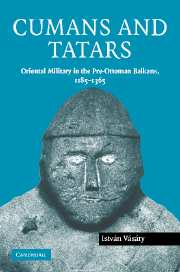Book contents
- Frontmatter
- Contents
- Preface
- 1 Introduction
- 2 Cumans and the Second Bulgarian Empire
- 3 Cumans in the Balkans before the Tatar conquest, 1241
- 4 The first period of Tatar influence in the Balkans, 1242–1282
- 5 The heyday of Tatar influence in the Balkans, 1280–1301
- 6 Cumans and Tatars on the Serbian scene
- 7 Cumans in Byzantine service after the Tatar conquest, 1242–1333
- 8 The Tatars fade away from Bulgaria and Byzantium, 1320–1354
- 9 The emergence of two Romanian principalities in Cumania, 1330, 1364
- Conclusion
- Appendix 1 List of geographical names
- Appendix 2 Chronological table of dynasties
- Appendix 3 Maps
- List of abbreviations
- Bibliography
- Index
5 - The heyday of Tatar influence in the Balkans, 1280–1301
Published online by Cambridge University Press: 29 July 2009
- Frontmatter
- Contents
- Preface
- 1 Introduction
- 2 Cumans and the Second Bulgarian Empire
- 3 Cumans in the Balkans before the Tatar conquest, 1241
- 4 The first period of Tatar influence in the Balkans, 1242–1282
- 5 The heyday of Tatar influence in the Balkans, 1280–1301
- 6 Cumans and Tatars on the Serbian scene
- 7 Cumans in Byzantine service after the Tatar conquest, 1242–1333
- 8 The Tatars fade away from Bulgaria and Byzantium, 1320–1354
- 9 The emergence of two Romanian principalities in Cumania, 1330, 1364
- Conclusion
- Appendix 1 List of geographical names
- Appendix 2 Chronological table of dynasties
- Appendix 3 Maps
- List of abbreviations
- Bibliography
- Index
Summary
GEORGE TERTER I (1280–1292) AND NOGAY
In 1280, with the conclusion of both the Bulgarian peasant uprising and the struggle for the throne, a new period began in Bulgaria's life. But it was not only in Bulgaria that, by the will of the boyars, a new ruler (and founder of a new dynasty) was seated on the throne. As was mentioned earlier, two leading powers of the area, the Golden Horde and Byzantium, also experienced a change of rulers. The khan of the Golden Horde, Mengü-Temür, died in 1280, and the Byzantine emperor Michael VIII, founder of the Palaiologos dynasty, passed away in 1282. The new rulers Tudā-Mengü (1280–7) in the Tatar state and Andronikos II (1282–1328) in Byzantium, though successors of the former imperial dynasties, proved much weaker than their predecessors, so the change of power in these countries led to a weakening of central power.
Until 1280 the traditional Balkanic lands, that is, the territories south of the Danube, belonged indisputably to the Byzantine sphere of interest. This statement is valid despite frequent nomadic incursions and the turbulance caused by them from time immemorial. Not even the Tatars of the Golden Horde questioned Byzantium's authority in Balkanic affairs. As we saw in the previous chapter, after a few years of uncertainty in Byzantium's northern policy, from 1272 onwards the western Tatar chief Nogay became tied to New Rome through firm matrimonial bonds. Nogay never hesitated to send his troops to help the emperor, his father-in-law and ally.
- Type
- Chapter
- Information
- Cumans and TatarsOriental Military in the Pre-Ottoman Balkans, 1185–1365, pp. 86 - 98Publisher: Cambridge University PressPrint publication year: 2005

